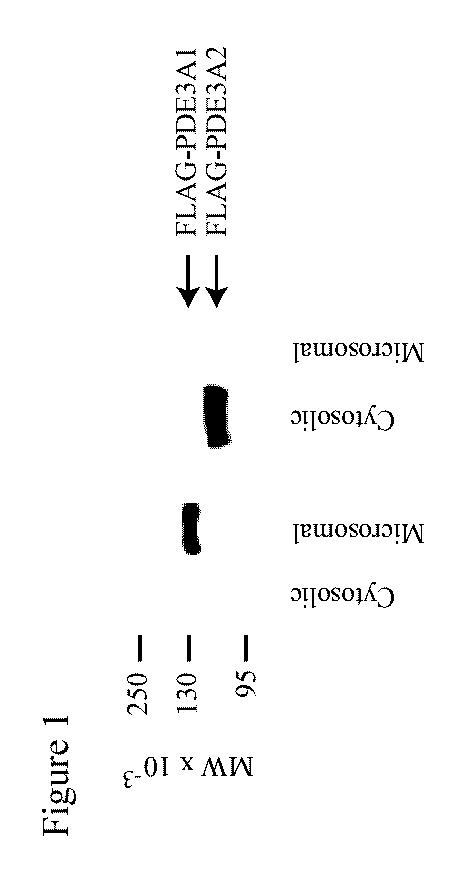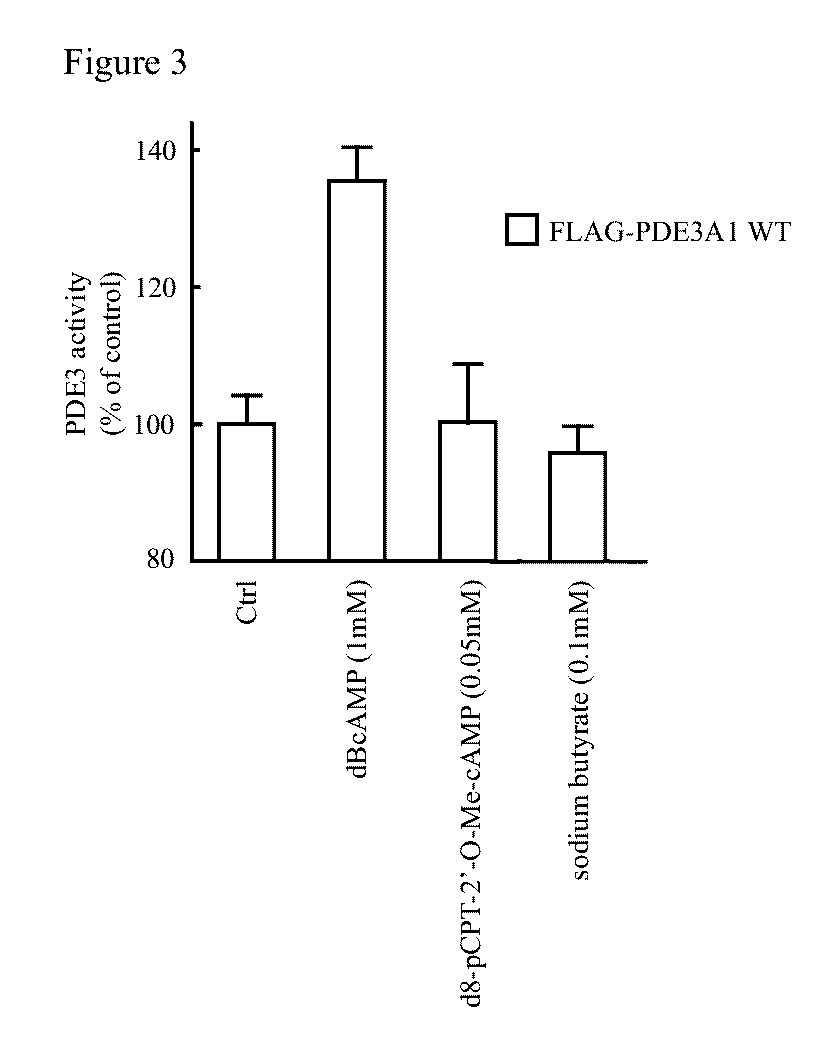Isoform-selective inhibitors and activators of PDE3 cyclic nucleotide phosphodiesterases
a cyclic nucleotide phosphodiesterase, isoform-selective technology, applied in the field of cardiac and other diseases, can solve the problems of affecting the long-term survival of dilated cardiomyopathy, the linkage between short-term benefits of pde3 inhibition and deleterious effects on long-term survival is problematic, and contribute to adverse effects on long-term survival. , to achieve the effect of reducing arrhythmogenic effects, reducing
- Summary
- Abstract
- Description
- Claims
- Application Information
AI Technical Summary
Benefits of technology
Problems solved by technology
Method used
Image
Examples
example 1
Materials and Methods
[0282]Preparation of rtPDE3A1
[0283]A human myocardial PDE3A construct was generated by inserting an eight amino acid Flag epitope (Asp-Tyr-Lys-Asp-Asp-Asp-Asp-Lys) immediately upstream from the stop codon of PDE3A1 (SEQ ID NO:14). Using 50 ng PDE3A1 cDNA as template (GenBank accession number NM_000921), PCR amplification was performed in a GeneAmp PCR system (Perkin Elmer, Wellesley, Mass.) with Pfu polymerase (Stratagene, La Jolla, Calif.) using 3 pmol each of sense primer corresponding to nt 3009-3027 of the PDE3A1 ORF:
[0284]
(SEQ ID NO: 4)CTTCATCTCTCACATTGTGGGGCCTCTGTG
and antisense primer corresponding to nt 3423-3403 and the Flag epitope:
[0285]
(SEQ ID NO: 5)TTTGCGGCCGCCTCGAGTTATTTATCATCATCATCTTTATAATCCTGGTCTGGCTTTTGGGTTGG.
[0286]The resulting PCR product contained a unique PDE3 DraIII site at the 5′ end and a stop codon at the 3′ end. The stop codon was flanked upstream by a Flag epitope-coding sequence and downstream by an XhoI site. The PCR products were sub...
example 2
PDE3 Isoforms in Cardiac and Vascular Myocytes
[0299]It has been shown that proteins of three different apparent molecular weights can be immunoprecipitated from mammalian myocardium with anti-PDE3 antibodies (Smith et al., 1993). These proteins are identified herein as PDE3 isoforms by Western blotting of cytosolic and microsomal fractions of human myocardium, using antibodies raised against peptides derived from the PDE3A ORF.
[0300]An antibody against the C-terminus of PDE3 (“anti-CT”) reacted with three proteins in these fractions. The largest, with an apparent MW of 136,000 on SDS-PAGE (“PDE3A1”), was present exclusively in microsomal fractions. Another PDE3 isoform, with an apparent MW of 118,000 (“PDE3A2”), was present in both microsomal and cytosolic fractions, as was a third isoform with an apparent MW of 94,000 (“PDE3A3”).
[0301]An antibody against an amino acid sequence between NHR2 and CCR (“anti-MID”) reacted with PDE3A1 and PDE3A2 but not PDE3A3. An antibody against amino...
example 3
Mechanisms for Generating Cardiac and Vascular PDE3A Isoforms
[0306]Addition of [35S]-labeled rtPDE3A (full-length ORF, SEQ ID NO: 14) to a sample of human myocardium prior to the preparation of cytosolic and microsomal fractions provided no evidence for the generation of smaller isoforms by proteolysis of the labeled full-length rtPDE3A (not shown). Other potential mechanisms were investigated.
[0307]The migration of cardiac and vascular isoforms of PDE3A were compared to those of recombinant proteins generated by in vitro transcription / translation. PDE3A constructs were prepared with 5′ deletions designed to yield rtPDE3As starting from different in-frame ATGs, inserted downstream from a T7 promoter and Kozak sequence. PDE3A1, PDE3A2 and PDE3A3 migrated with the same apparent molecular weights as the rtPDE3As starting at ATGs 1507, 1969 and 2521, respectively. This is consistent with the three PDE3A isoforms being generated by transcription from alternative start sites. Transcriptio...
PUM
| Property | Measurement | Unit |
|---|---|---|
| temperatures | aaaaa | aaaaa |
| angle | aaaaa | aaaaa |
| concentration | aaaaa | aaaaa |
Abstract
Description
Claims
Application Information
 Login to View More
Login to View More - R&D
- Intellectual Property
- Life Sciences
- Materials
- Tech Scout
- Unparalleled Data Quality
- Higher Quality Content
- 60% Fewer Hallucinations
Browse by: Latest US Patents, China's latest patents, Technical Efficacy Thesaurus, Application Domain, Technology Topic, Popular Technical Reports.
© 2025 PatSnap. All rights reserved.Legal|Privacy policy|Modern Slavery Act Transparency Statement|Sitemap|About US| Contact US: help@patsnap.com



